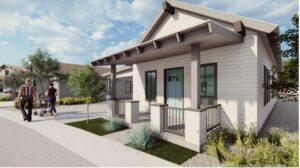
Photo Credit: Phoenix Business Journal
We don’t need to tell you that the housing crisis in Arizona is one of the most important issues that impacts so many Arizonans. We have led the country in rent increases, and the median home price has risen exponentially and now tops an eye-popping $500,000. And we have spoken plenty about the need for more housing options; increasing supply as a way of driving down price.
That said, an issue that is so pervasive needs innovative solutions from a few different angles. A Scottsdale developer has a relatively new idea that he thinks could help alleviate the pain of prospective homeowners who are quickly being priced out; manufactured homes and land leasing.
The new company TerraViva is headed up by someone with strong local ties: its Principal Jim Mullin was once the Economic Development Director for the city of Scottsdale. They have proposed three projects with a strong tilt towards affordability. The buyers purchase the residence but not the underlying land, which they lease from the landowner. Since land ownership is one of the more expensive parts of home ownership, this ostensibly should drive down the cost of the purchase, as well as the fact that the homes are manufactured. While perhaps not as glamorous as more traditionally built homes, they certainly provide adequate structure nonetheless.
This is just one approach to driving down housing costs; another that has gotten a good amount of press recently is, believe it or not, 3D printed homes. Habitat for Humanity has gotten onto this trend, and recently put a Tempe family in a 3D printed home. While the idea of a “printed” home may conjure up thoughts of it blowing away in the wind, in reality many durable materials can be used with this process, and it offers up potential.
TerraViva estimates that their homes will sell for between $200,000 and $280,000 before the cost of leasing the land. The leases will be in one-year increments, will reset after that time, and proceeds from the lease will be funneled into amenities for the community. The elephant in the room would of course be the monthly costs of those leases. If it is a couple hundred dollars per month, it does truly seem affordable, but if it edges up to $1,000 per month, the affordability of it essentially evaporates when the payments for the construction loan are considered.
Regardless of true affordability, it is a positive that new and innovative ideas are being considered. The traditional single-family home mortgage has served as well as a society, but when new challenges arise, the ability to think outside the box is critical, and more ingenuity is always welcome.

